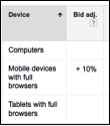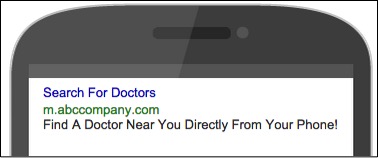With Google’s recent announcement that a site’s “mobile friendliness” will soon impact its organic ranking on mobile devices, I started thinking about mobile PPC campaigns. In a sense, the two are related. Though the former is SEO-related, the end goal is still the same, isn’t it? We all want visibility and conversions on mobile devices, whether we’re utilizing SEO or PPC strategies to get there.
The bottom line is that there is a limited amount of available real estate available on mobile devices and we need to be smart and strategic on how we get our ads to appear in the right place at the right time. In this piece, I will discuss some PPC tactics that will help bring your mobile presence to the forefront.
Why Is Mobile Any Different?
There’s a question I’ve heard time and time again. “My site converts well on desktop. Why should mobile be any different?” While some advertisers might initially believe that what works on desktop will work the same on mobile, the answer is a resounding no. Take a look at your site on a desktop and then view it on a mobile device. You’ll most likely see that you now need to scroll down in order to view items that appear above the scroll on a desktop. Take a look at your product pages. Is the pricing visible on a mobile device?
As you can see, there are definitely some potential challenges associated with using your desktop experience on a mobile device. Before you invest any significant budget in mobile marketing, a good first step is to have a solid mobile experience in place.
Keyword Selection
Now that you’ve got a mobile landing page in place, it’s time to formulate a keyword strategy. While some advertisers may think that the keywords that perform well on desktop will perform similarly on mobile, there is a lot of data to prove that isn’t always the case. Keep in mind that there is different user intent among devices and keyword selection has to be adjusted accordingly.
For instance, a long tail query that converts well on desktop may never even garner an impression on mobile due to the sheer volume of words in that query. Experience has shown that broader queries tend to perform well on mobile. Part of the reason can be attributed to the length of the query, while the intent of a user on a mobile device may also be closer to the top of the funnel than a desktop user. Consider these factors as you decide which keywords are going to be a part of your mobile campaign, as it can make all the difference.
Bid Modifiers
Once you’ve got a keyword list in place, you’ll want to make sure you apply bid modifiers at the campaign and ad group levels so that you don’t waste valuable marketing dollars on keywords that don’t perform well on mobile. Conversely, you may want to bid up on the terms that do, increasing your ability to garner some of that precious mobile real estate. Continually look at your mobile performance and utilize those bid modifiers as a tool in gaining the best exposure possible on mobile devices.

Mobile-Preferred Ads
We have the ability to provide our users with mobile-preferred ad copy of which we should take advantage. While some advertisers may not feel that there is any benefit in doing so, others might want to use this feature to simply call out in their ad the fact that the user is on a mobile device.
For example, while your desktop ad copy might say, “Find a doctor near you,” your mobile ad copy could say, “Find a doctor near you directly from your phone.” Ad copy adjustments like this one reinforce with the user that the service you provide is mobile-friendly. If they go through your user experience they can get exactly what they need without even putting down their mobile device. It’s definitely worth putting some time into devising mobile-preferred ads that will better connect with your users.


Mobile Messaging
Besides utilizing mobile-preferred ad copy to let your users know that your product or service can be found on their mobile device, you should also pay attention to the structure of your ad. As we know, a mobile screen size is going to be smaller than a desktop, so ad copy that is brief and simple tends to perform better. Pick up your phone and do a search and take note of which ads catch your attention. Chances are that the longer, more complicated ads appear confusing on a mobile device. Keep it simple!
Dayparting
Dayparting can be a very valuable tool in your mobile marketing efforts – especially if you have a business that stops taking calls after a certain time of the day. Using this feature, an advertiser can minimize wasted ad spend and prevent the phone from ringing when no one is there to answer. But that’s not the only reason why dayparting might be a good option for your mobile campaigns. Just as we do with desktop, take a look at your low-converting times of day and decide if dialing down your campaigns at that time makes sense. And remember that the dayparting schedule that you use with your desktop campaign is not necessarily the same schedule that you should use for your mobile campaign.
Final Thoughts – Keep On Testing
As we all know, PPC is by no means an exact science (if it was, we’d all be bored). With that said, a mobile strategy that works for one advertiser may not work for you. Therefore, it may be a good idea to create several variations of your mobile ads and test them. Keep a close eye on your metrics and learn what messaging resonates best with your users. The more we know about user behavior, the better we can market to them. And testing is the only way we are going to accomplish this goal.



